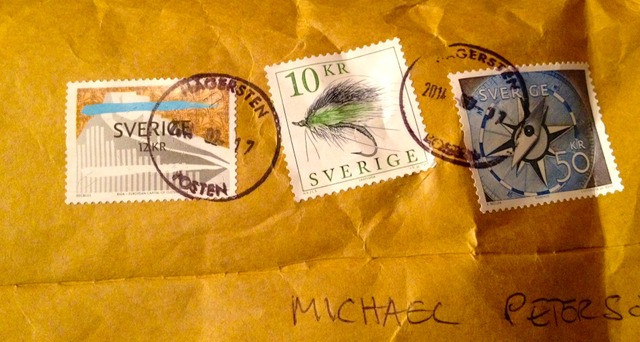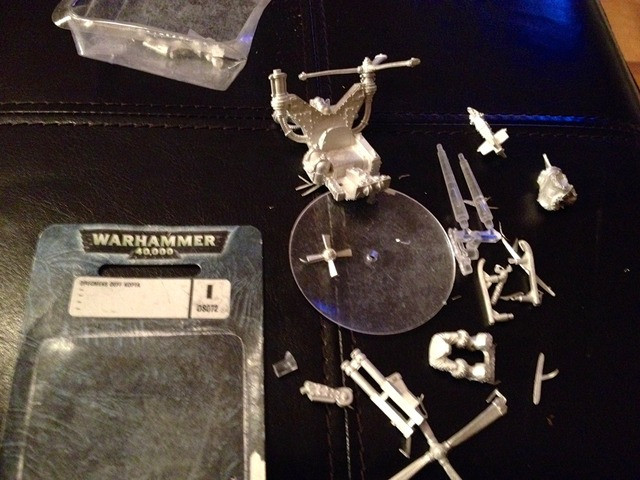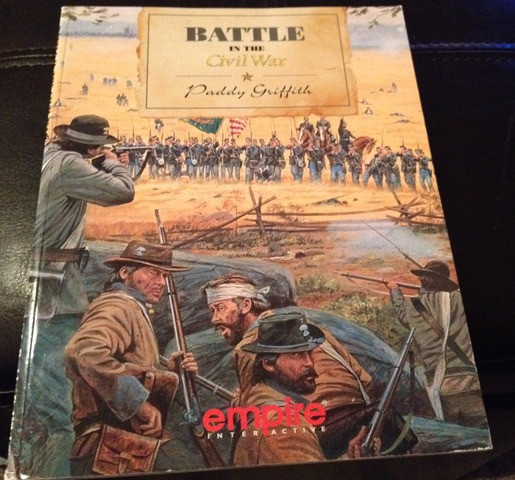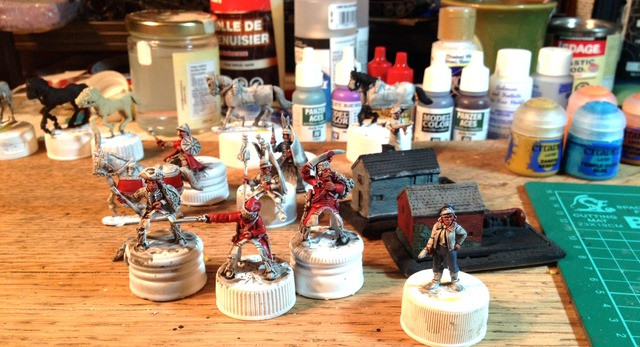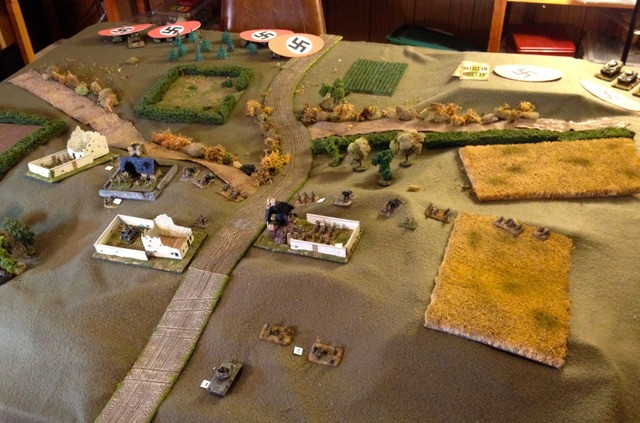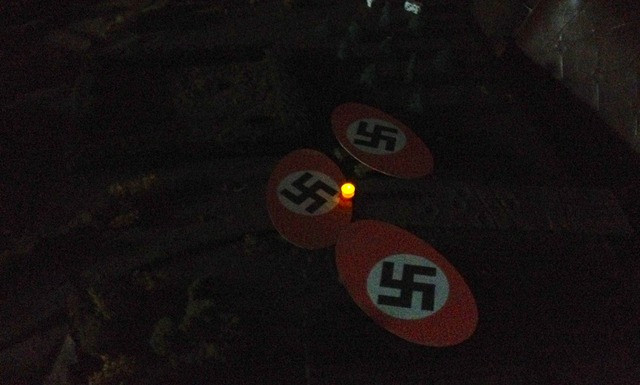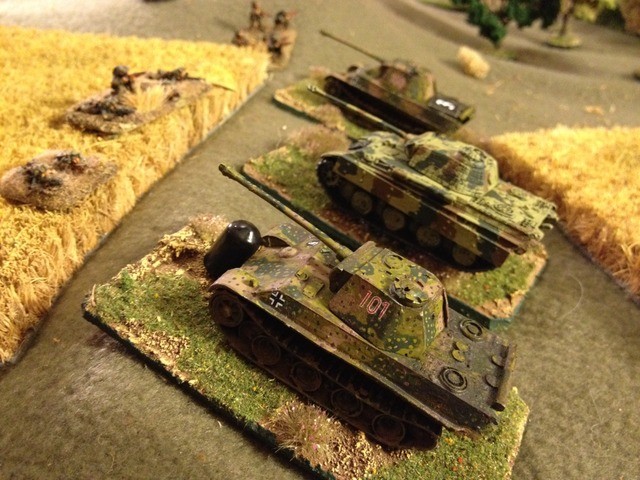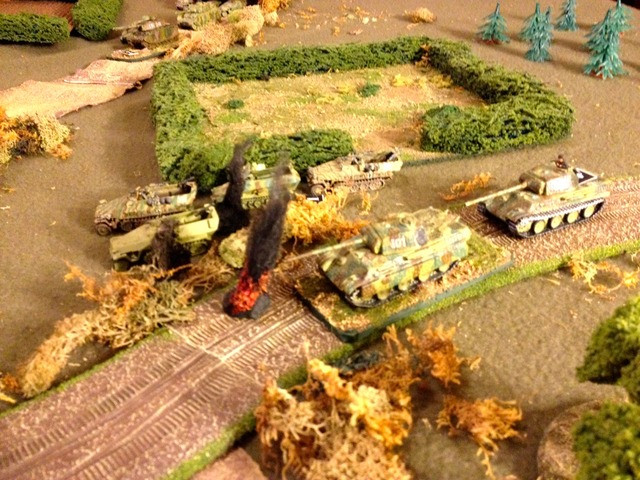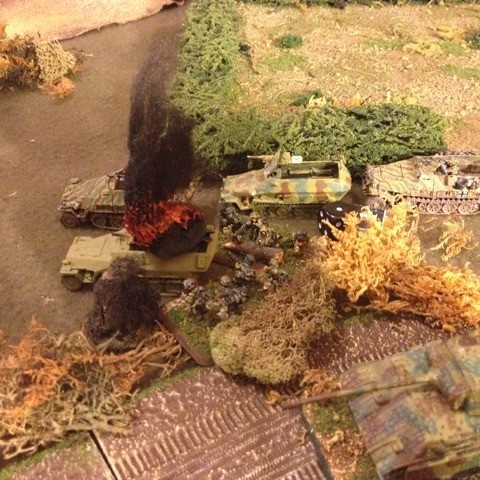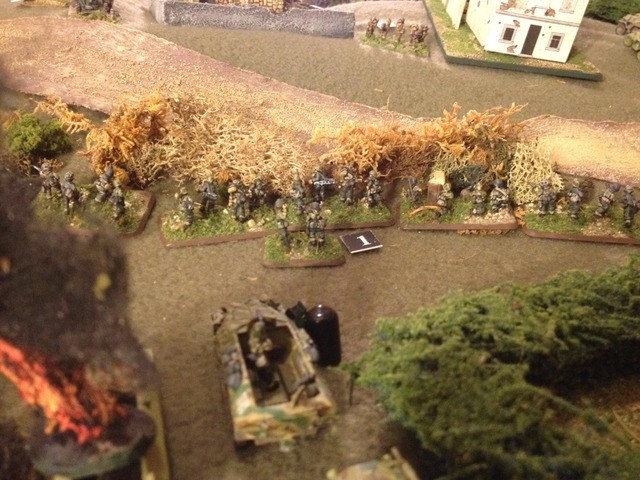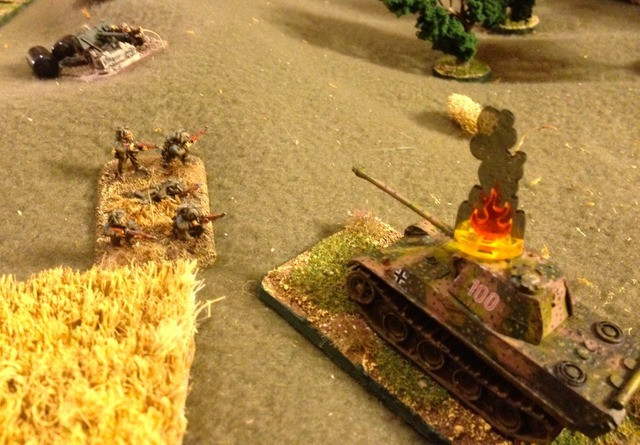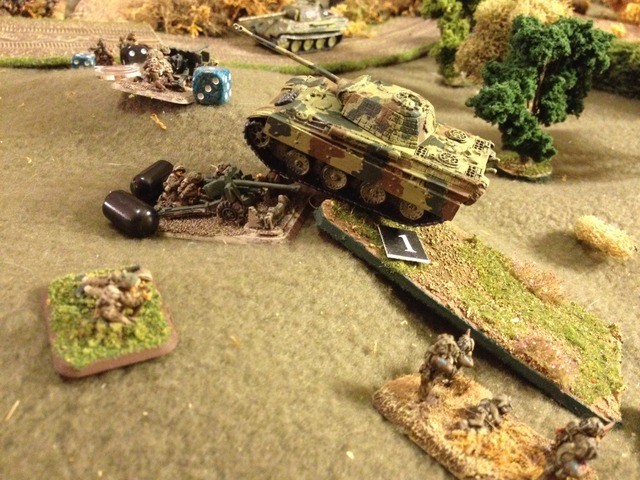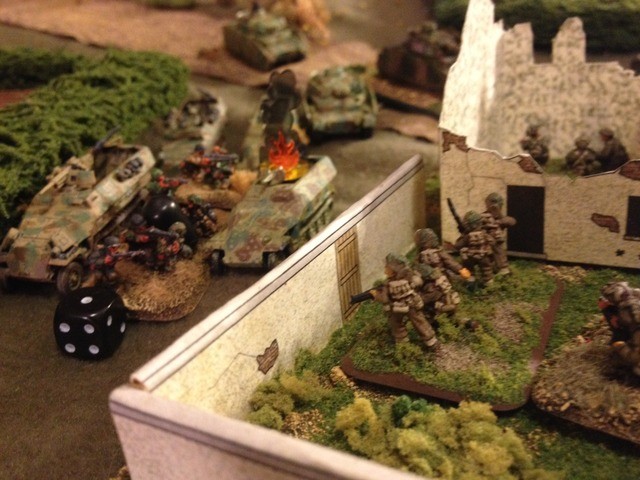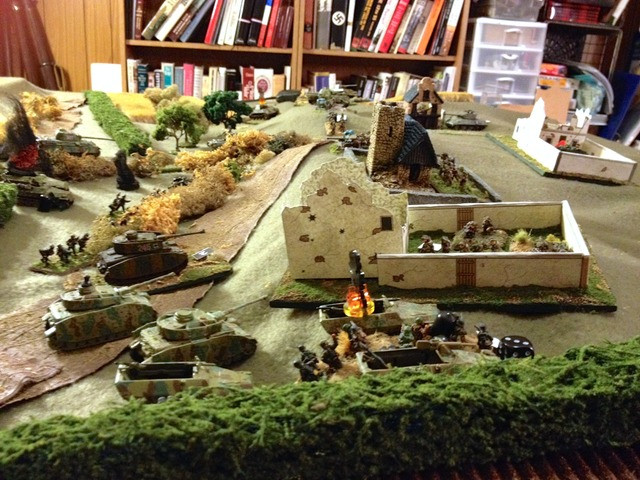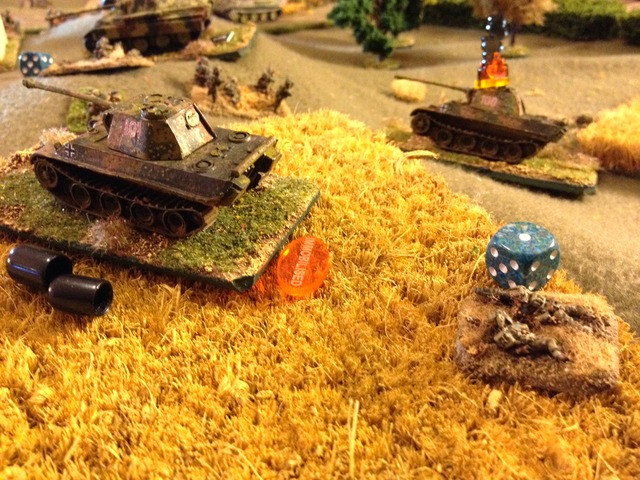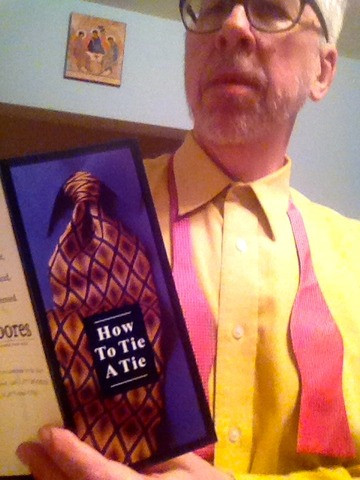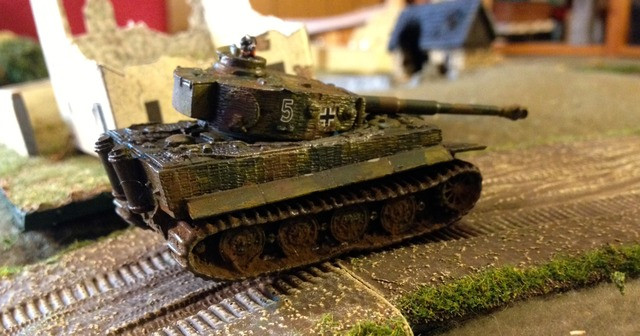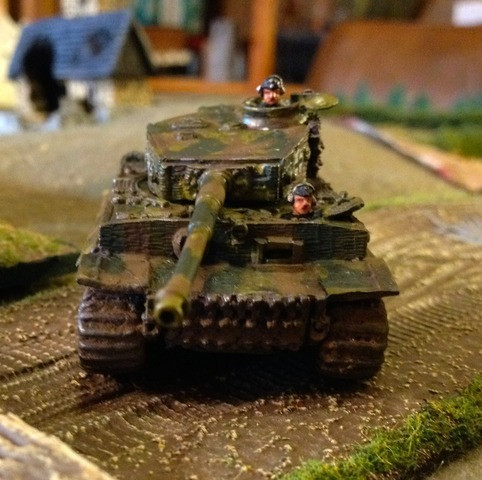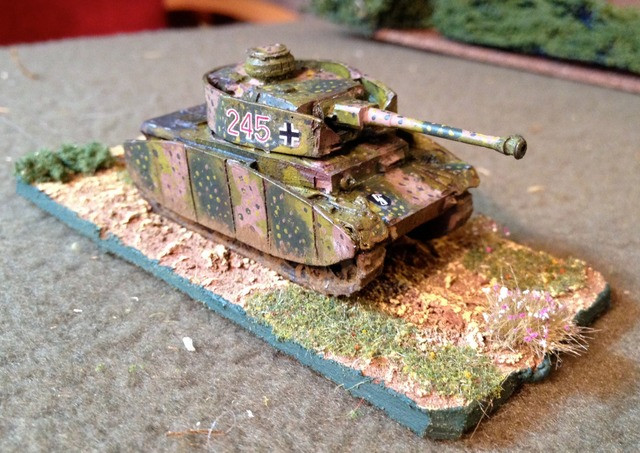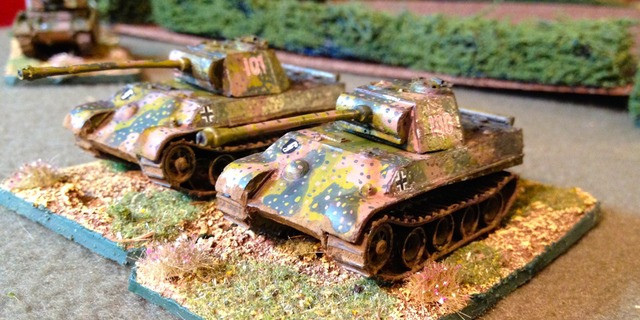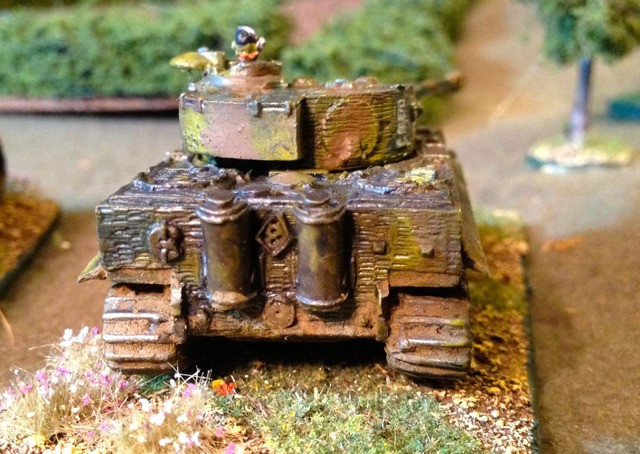Some readers of my last post on this battle commented that the last photo only showed me with an untied bow tie, looking rather perplexed. I was indeed perplexed. Thank goodness for HowTo videos on YouTube. I did complete my first hand-tied bow tie and looked rather natty as I took Mrs. Padre to the jazz club for Valentines Day. Readers interested in that sort of thing can scroll down to the bottom to see that and to read the Padre’s advice for a happy relationship.
Picking up on where I left off, a confusing night action in Normandy got far more confusing and vicious before it ended.
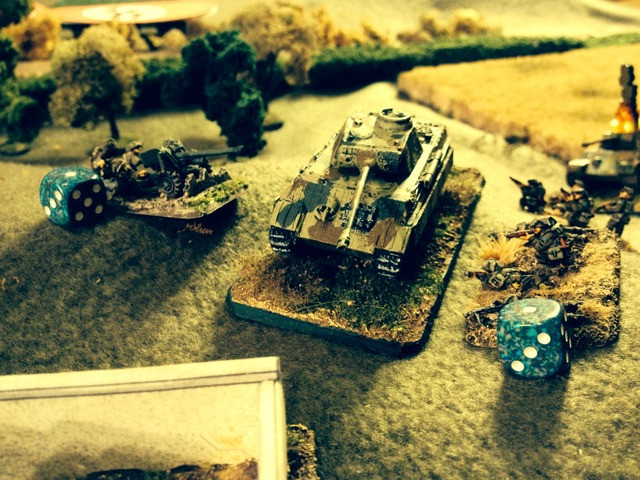
Here one of the Panthers attacking the Canadian right flank rests, digesting its prey, a 6lber AT gun which it overran and crushed in its move, avenging its littermate, seen burning in the back right. To the left, the AT gun’s section partners frantically pivot their gun, using one of their three actions. Their other two actions go for an aimed shot on the Panther’s flank at near point blank range. Incidentally, the blue dice are used to track Canadian casualties. On my
patented blanket terrain system, these dice behaved sub-optimally, frequently rolling away down slopes and getting me muddled as to who took what casualties.
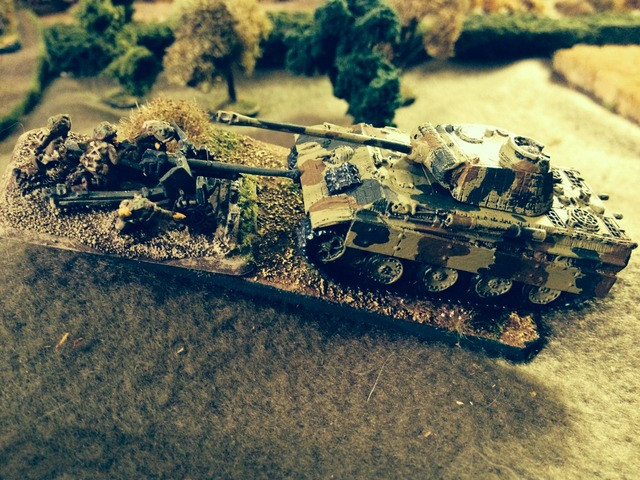
Unbelievably, the AT shell fails to penetrate and the Panther suffers no adverse results. Even in the dark, the tank commander knows that someone just rung his doorbell. He pivots and drives forward, crushing his second AT gun. Unlike the first overrun, I read the rules more carefully and learned that in an overrun, if infantry roll higher than any shock points they may have accumulated, they get another chance to use their AT weapons. I hadn’t done this for the first 6lber crew, but I figured it made sense to give the crew one more chance as the beast bore down on them. Of such things medals and heroes are made. Alas, not this time. The second shell missed and the Panther had its prey. Nom nom nom.
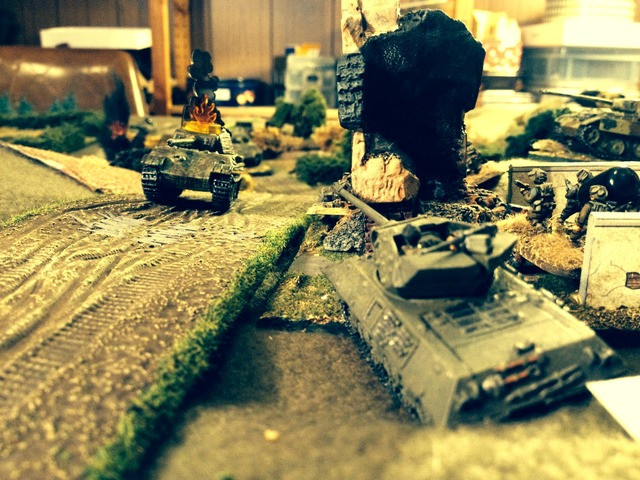
However, it’s not going all the way of Jerries. The supporting Cdn Achilles tank destroyer has snuggled up against the rear of a ruined house, enjoying the protection of the defending infantry and covering the road in overwatch. The German Dynamic Leader card comes up and the armour commander rolls forward, determined to get in the centre of the position and wreak havoc. He comes on slowly, 1 action for movement and the other two for spotting, but sees nothing in the dark. Just then, the Cdn CO, Maj. LeBlanc, sends up another precious flare. The Achilles sees the Panther lit up and immediately fires, it’s 17pdr gun ripping through the front armour like tissue. The Panther explodes, killing its crew and leaving the German armour leaderless.
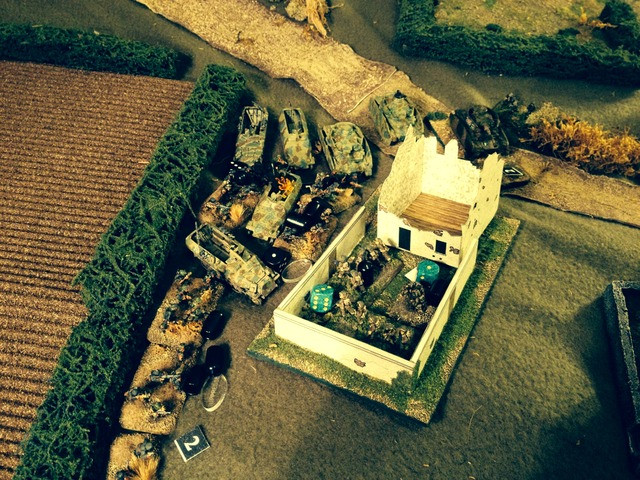
On the Cdn left, the German panzer grenadier platoon dismounts and soaks the house and garden with fire, supported by their halftrack’s machine guns. The Canadiens don’t suffer much as I treat this as speculative fire, and return fire at the gun flashes and shadowy forms lit by the burning Hanomag. The Vickers gun is particularly effective. However, when the German tanks join in, the Vickers is silenced, while Cdn infantry casualties slowly mount.
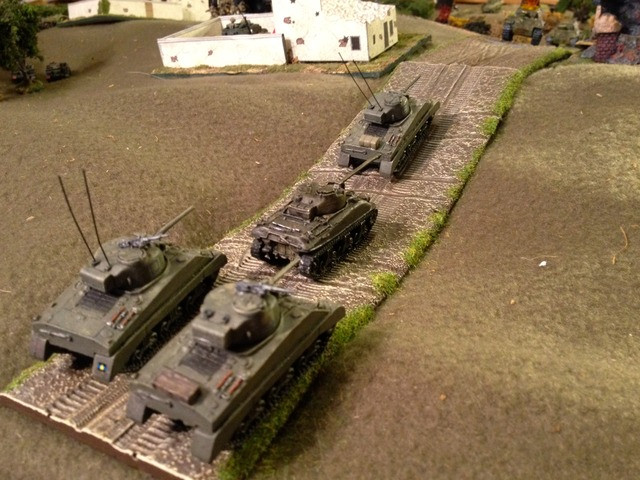
Good news for the defenders. A troop from the nearby 1st Hussars quick reaction force enters from the Canadian centre edge.
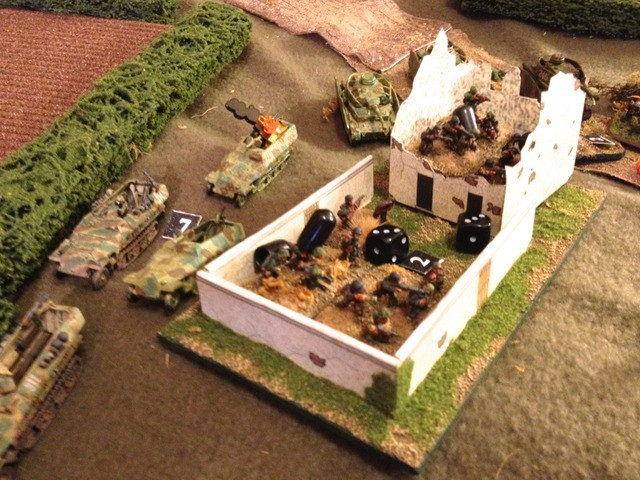
However, bad news for the Canadians as the 2nd grenadier platoon assaults the house. They lose men but evict the defenders, who are now down a house as well as losing an infantry section, a PIAT team, a 2” mortar team and a Vickers HMG team.
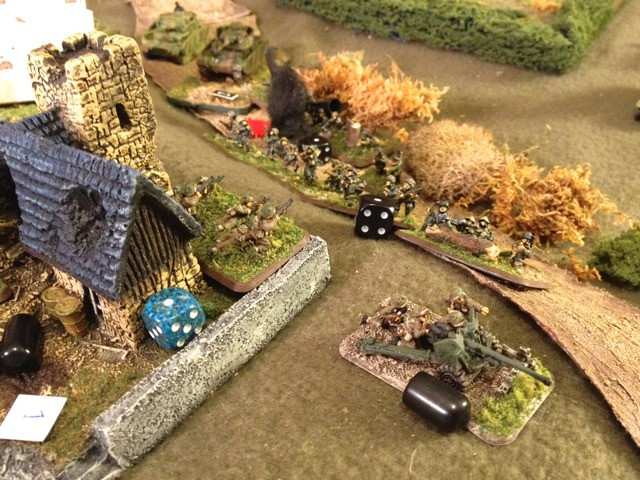
Even though it is now getting some attention from the defending mortars, the 1st Grenadier platoon rushes forward up the hill to take the church, emboldened by their colleagues’ success. This charge is occasioned by the German’s getting the Heroic Leader card, a one-time opportunity to do something splendid. The young Leutnant leads his men through the mortar shells, his inspirational example removing a point of shock from the PzGrs and inspiring them to follow. Two sections tack the Canadian section in the church, while the third rushes at the last surviving 6lber gun.
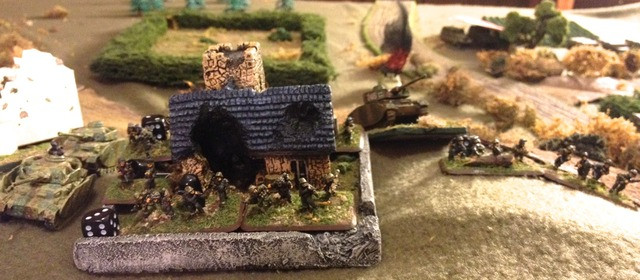
Success. The Cdn defenders are killed or captured and the AT crew put to flight. The Germans take some losses, but now hold two of the three buildings they need to win. The PzKw IVs move up to support their little friends in the captured church.
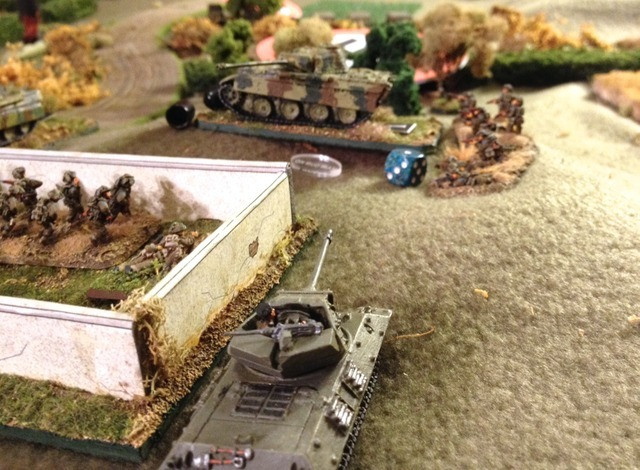
The Achilles claims its second victim, sneaking around a corner to get a flank shot at the third Panther on the Cdn right, it’s spotting attempts helped by friendly infantry. The Panther takes two in the gut and explodes.
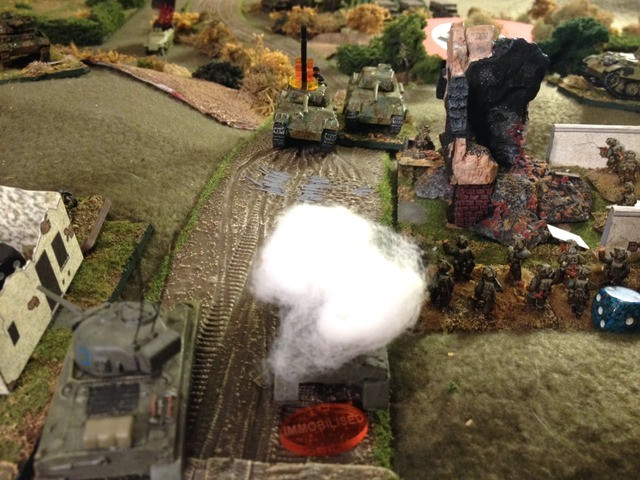
Nearby, aggressive German training wins over self-preservation. The surviving tank of the Panther HQ troop moves forward beside the pyre of his boss and engages two of the relieving Shermans. The Panther is brightly lit, the Shermans are just shadowy forms, but by aiming at the muzzle flashes the Panther immobilizes first one, and disables the gun on the other. Both Sherman crews bail out, but not before causing some damage to the sights on the Panther.
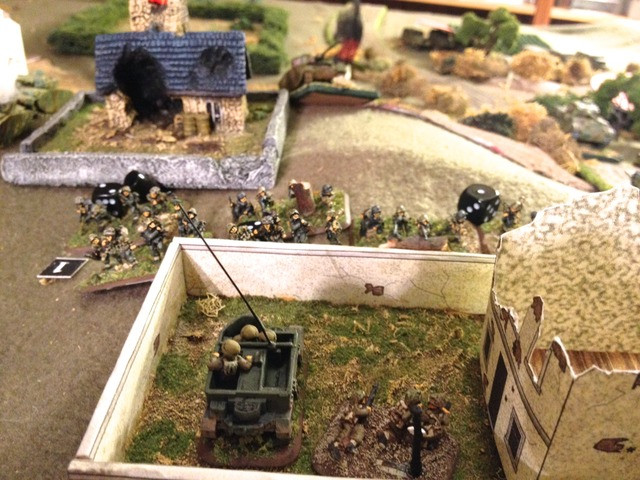
The PzGr 2nd platoon sees an opportunity to take a third building while it is relatively unoccupied. Major LeBlanc’s company HQ stand bugs out just in time.
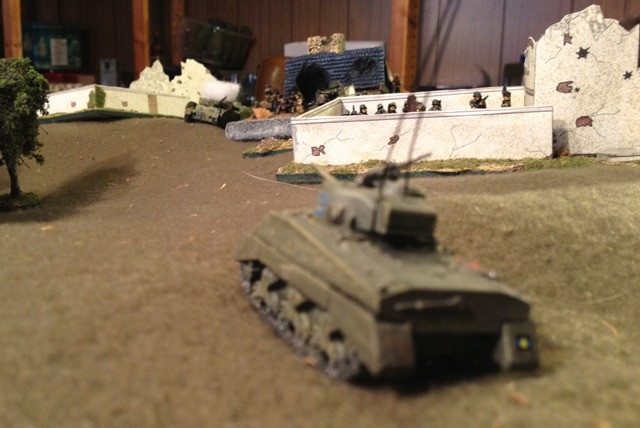
One of the relieving Shermans knocks out an advancing PzKwIV.
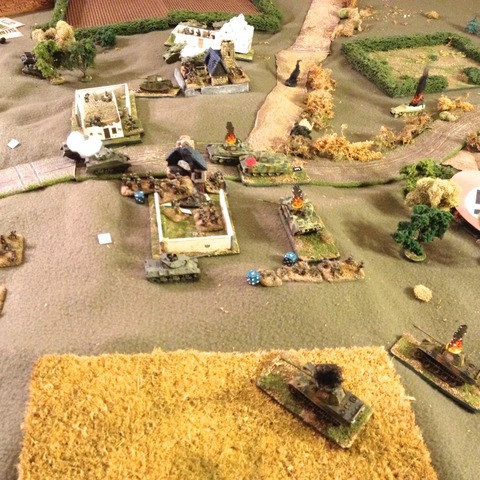
The situation this far. Only one Panther is left in action in the centre. The Canadians now hold only one of the four buildings. A section of Canadian infantry still holds the woods on the top left, forcing the Germans to keep their precious infantry in their captured buildings to precent recapture. The blind visible on the extreme right edge is the German company HQ (Big Man, two HMGs, and a tank killer section moving into the woods at the base of the ridge.
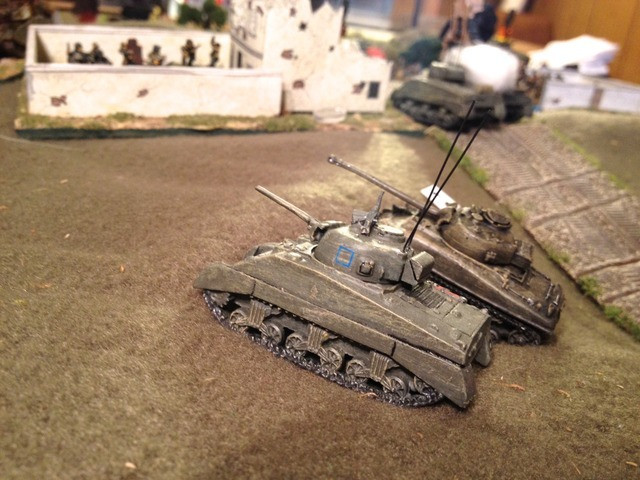
The two Canadian Shermans take cunning hull down positions in the blanket fold terrain, keeping a wary distance from the German infantry and their panzerfausts to their front.

Those Shermans have to go if the Germans are to capture the road at the table edge. A squad of grenadiers and their two panzerfausts are sent out to deal with them. Both shots miss badly. The Grenadiers wisely withdraw before they are cut down by HE and coax fire.
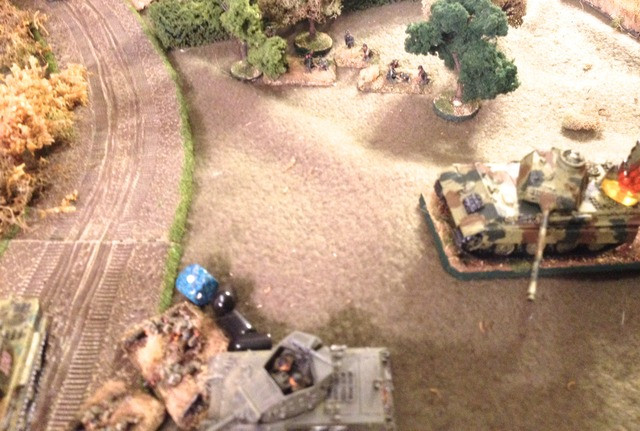
The Achilles and an accompanying section of infantry, with Pte Blondin, the intrepid PIAT gunner, are trying to outflank the remaining Panther but are caught by the two HMGs now set up in the wood, when the German HQ card comes up. Several Canadians fall, but fortunately not Blondin. The survivors of the section are badly shocked. The German company commander also uses the card to send his tank killer team forward with two actions, hoping to use their remaining action to hit the Achilles with a panzerfaust.
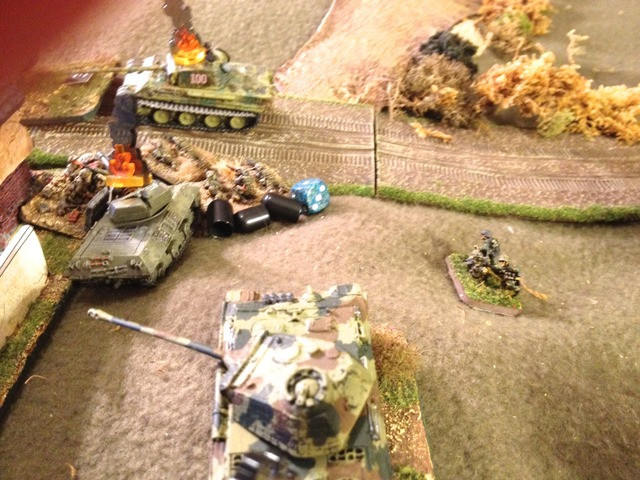
They succeed. The Achilles explodes nastily. They won’t claim their hat trick this game.
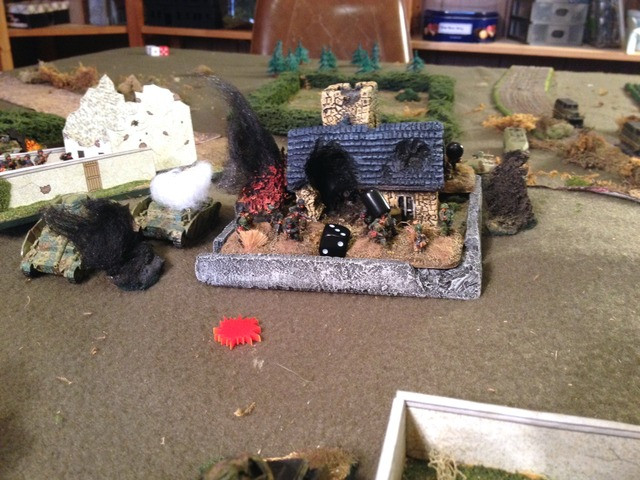
But fortune goes both ways. Having relocated and regained their composure, Maj. LeBlanc and his FOO bring 25lber shells down on the church, chipping away at its defenders. LeBlanc fires his very last flare (the red blob in this picture), which has decisive results. It catches the two surviving PzKwIVs in its deadly light, and they are engaged by the two Shermans from their protective darkness. The Firefly brews up the troop leader, and his mate shocks the lone survivor into retreating. With that reverse, and a steady stream of HE now falling, and with fears of more of those flares, the Germans have probably felt they’ve done enough, and would likely think of withdrawing.
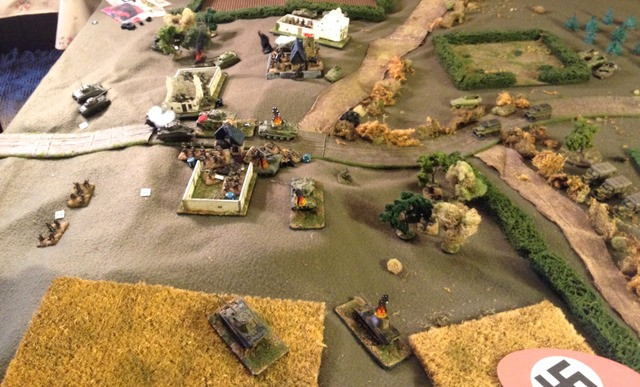
German high-water mark. The game ends with three out of four objectives held, giving the Germans a partial and pyrrhic victory. My observations about night actions is that they are best avoided. As far as possible, I handicapped the German attack by forcing them to advance into unpleasant situations and to take punishment from an unseen foe. The difficulty of maneuvering at night over unknown ground also slowed the German advance. While there were several occasions where the cover of darkness minimized German casualties from defending fire, there were others where the German armour, caught by flares, took losses from the Shermans that could essentially hide in the darkness and pick them off. This would have made a terrifically tense action with an umpire, given the right players.
In the action I was basing this on, the Chaudieres beat off the German attack but lost a platoon in the process, which roughly coincides with this outcome. One can see why the Germans largely refrained from night actions after the first few days of the Normandy campaign.
To finish, here are the Padre’s two suggestions for a happy relationship. First, make a big deal of Valentines' Day and other such occasions. Dress up and go out somewhere. Ms. Padre and I enjoyed a romantic evening at the local jazz club. And yes, I did achieve a major victory over the bow tie, with some spousal assistance. Bow ties are cool.

Second, share the wargames table. I forced myself to finish this action in two days rather than drag it out forever, so Ms. Padre could get back to her jigsaw puzzle, cleverly protected by a sheet of plexiglass. She thinks I have patience painting my little men. I admire her patience with jigsaws, as I can’t stand ‘em.
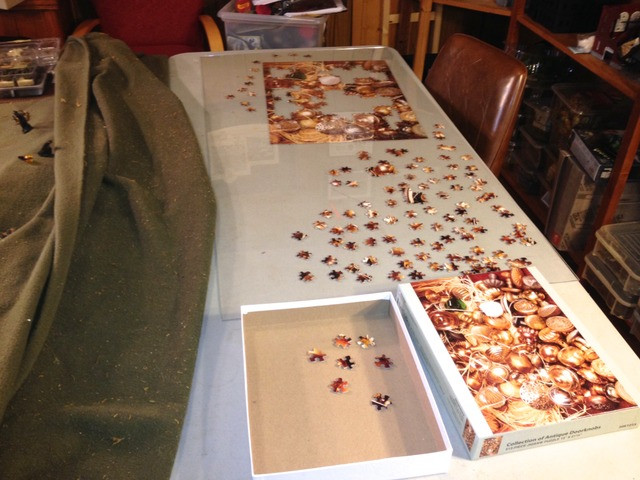
Thank you for reading this long two-part bat rep. Blessings to your brushes and die rolls!
MP
